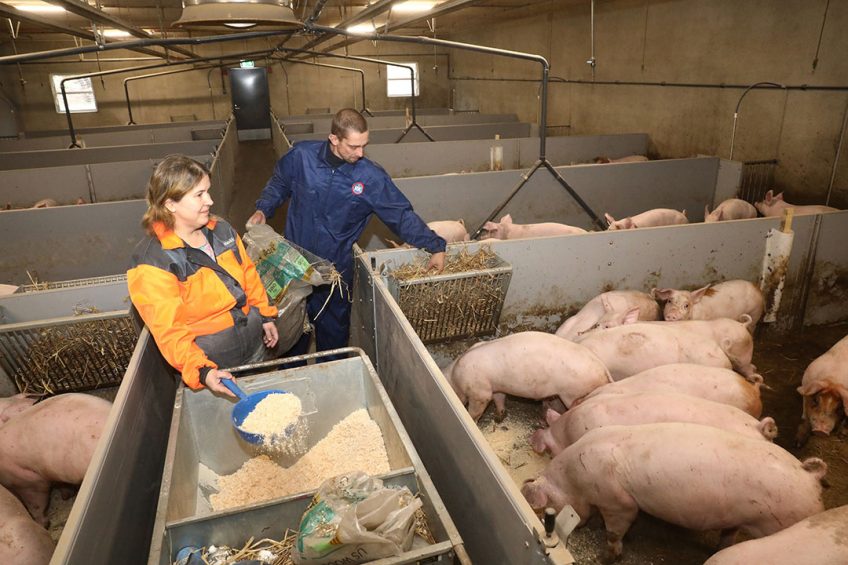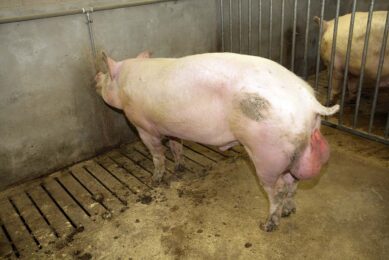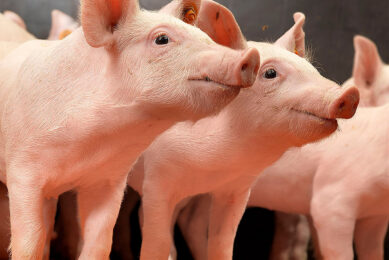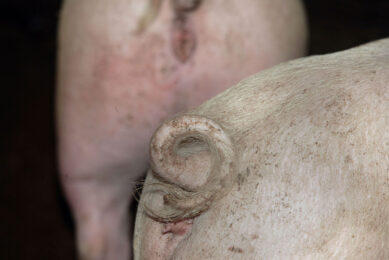Curly tails, great health and 1kg daily growth

In Finland, tail docking was banned 17 years ago. The Finnish pig industry has had to developed methods to minimise tail biting. Pig producers Rami and Susanna Yrjälä learned that excellent feeding conditions help prevent tail biting. Their approach delivers excellent technical results.
In Finland, environmental restrictions do not have to be in the way of livestock production. After all, the latest finisher pig house of the Yrjälä family is located in the middle of the forest. In addition, the family are the only pig producers in the area. Exactly one year ago, the new pig house with a capacity of 1,300 finisher pigs was taken into use by Rami and Susanna Yrjälä. In fact, that meant the farm size capacity doubled as the couple already had a pig house with a capacity of 600 finisher pigs and a weaner facility with an additional 300 places. To fill these two pig houses, the couple purchases weaned pigs at around 7kg.
The new pig house is built robustly with plenty of space. Up to the gutters, the walls are made of concrete and insulated panels were used to form the roofs. In the front of the pig house, there is a space for a feeding kitchen, heat exchanger, office and hygiene entrance.
The youngest piglets in the new pig house entered about one month ago. The temperature is 18.5ºC, with the floor being heated. The farm uses manure cooling in combination with a heat exchanger. That essentially means that the manure’s warmth is being used to warm the floor as well as raise the drinking water’s temperature to 17ºC. After all, the well water is cold as ice. On a daily basis, about 12m3 is heated. An additional advantage of cooling the manure is that the smell is relatively fresh in the different parts of the farm, as cooling reduces the formation of ammonia.
| PROFILE Function: Owners of Yrjälä farm, near Mynämäki, Finland. Farm: Yrjälä farm is a wean-to-finish facility with 1,800 finishers and 300 weaner pigs. The farm achieves 1 kg/growth per day and has a 2% mortality rate. The farm sends its pigs to HKScan; the finishers have a lean meat percentage of 59%. |
What’s more, the emissions are further reduced because of the small emitting surface, as the majority of the pen floor is closed, not slatted. In total, the pens are 5.45m long and 2.45m wide. The slatted floor is 1.76m long, with a 44cm drain made of narrow holes through which urine can flow away.

Tail biting and feeding
Since 2003, Finland has banned the practice of tail cutting. As a result, the Finnish have needed to learn how to prevent tail biting. Experience shows that suboptimal feeding conditions form the biggest risk for tail biting.
The Yrjälä family therefore pays plenty of attention to correct feeding and nutrition. The farm decided to provide liquid feed to the pigs, which is served four times per day. The troughs are not allowed to be empty for long. This keeps the pigs’ gastro-intestinal tract healthy while ensuring that the pigs do not start to get hungry.
Also the feeding method – in stainless steel troughs almost 5m long – helps create optimal feeding conditions. With long troughs, all thepiglets can eat simultaneously and ingest sufficient feed at the same time.

Susanna Yrjälä explains, “We’ve found a feeding curve in which the feed intake is optimal. A high feed intake is an important way to prevent tail biting. From experience we know that when things are stable with finisher pigs, the risk of tail biting is minimal.”
The pigs are fed a complete feed until about one month after entering the finisher facility. For that, the Yrjälä family provides feed from the same distributor that supplies the multiplication farm. After this month, within three days, the Yrjälä farm switches to feed which is based on its own-produced raw materials, mainly consisting of wheat and barley. The grain is mashed and with a hammer mill added to the mixer. This is filled with the pre-heated water. The liquid feed is then finished off with an additional feed component. With this diet, rich in grains, the pigs are thriving. Between 30 and 120kg, the gilts and barrows easily reach 1kg growth/day. That high average growth figure includes a small percentage of underachievers.

Great animal health
The excellent growth figures are also related to a great pig health status. Finland is free of Mycoplasma hyopneumoniae (M. hyo) as well as Porcine Reproductive and Respiratory Syndrome (PRRS). That means that the animals come closer to reaching their genetic potential. The first pigs will go the slaughterhouse 11 weeks after entering the finishing barns. New weaner pigs arrive every 14 weeks, which gives the farmers four days to completely clean and dry the pig houses.
The pigs are also free of Salmonella. Finland has a zero tolerance policy towards Salmonella for the entire livestock industry. For that reason, pig producers cannot just purchase feed from any given feed manufacturer. All feed producers have to be able to demonstrate that they supply feedstuffs that are free from Salmonella.
The farm’s multiplier is using a Danish genetics source, but is in the process of switching to TN-70 sows of Topigs Norsvin, with a Danish Duroc as terminal sire. The end product in the finisher house is therefore a mixture.

Tail biting and pig focus
Keeping pigs with entire, curly tails requires management which is focused on the animals themselves. Key in that process is that pigs should not experience any stress. Nutrition, health and pig house climate have to be right all the time. As a bonus, the pigs are supplied with straw as well as sawdust on a daily basis. Sawdust helps to keep the floors clean, as much of these floors is closed.

The Yrjälä family are pleased with their farm’s new addition, which cost roughly € 600 per place. That amount includes the delivery zone as well as the feeding kitchen. For the construction the farm used Finnish builders; and insurance companies also played a role. The ceiling is made of wood, which is not as dangerous as plastic in case of fire – and there are smoke detectors attached to it. Throughout the entire pig house, there is a red air duct with subtle holes. The air flows through this duct to the smoke detector, which sends an alarm to the farmer if ther’s a fire. The investment in this system was € 2,000, which is partly covered by the insurance company offering lower fire insurance rates.
| Entire tails and carcass defects Recent research at Finnish meatpacker HKScan has shown that there is a 100% match between entire tails and carcass defects on the slaughterline. As soon as research shows that more tails have been bitten, then there is also a higher frequency of other types of abscesses as well as joint problems. In other words, HKScan is pleased to state that when a pig makes it to the slaughterline with an intact tail of 24 cm or more, without carcass defects, it will have had a good and pleasant life. |
The pigs will be sent to the cooperative meatpacker HKScan. This slaughterhouse has been supporting the construction of new pig houses by adding a premium of € 0.03/kg for several years. For the Finnish market, the pigs produced are regular. As the country is virtually self-supporting in pigmeat, price fluctuations are lower than in other European markets. In 2018, pigs were sold for roughly € 1.52/kg slaughterweight. At the end of 2019, the price was even € 0.10 higher than that.
 Beheer
Beheer








 WP Admin
WP Admin  Bewerk bericht
Bewerk bericht